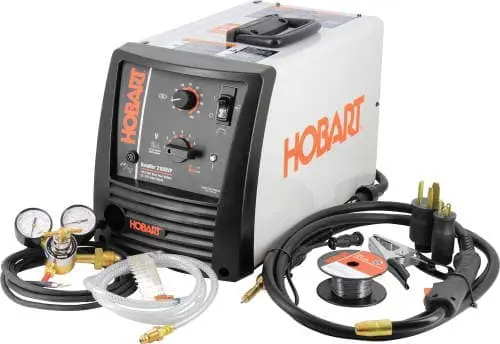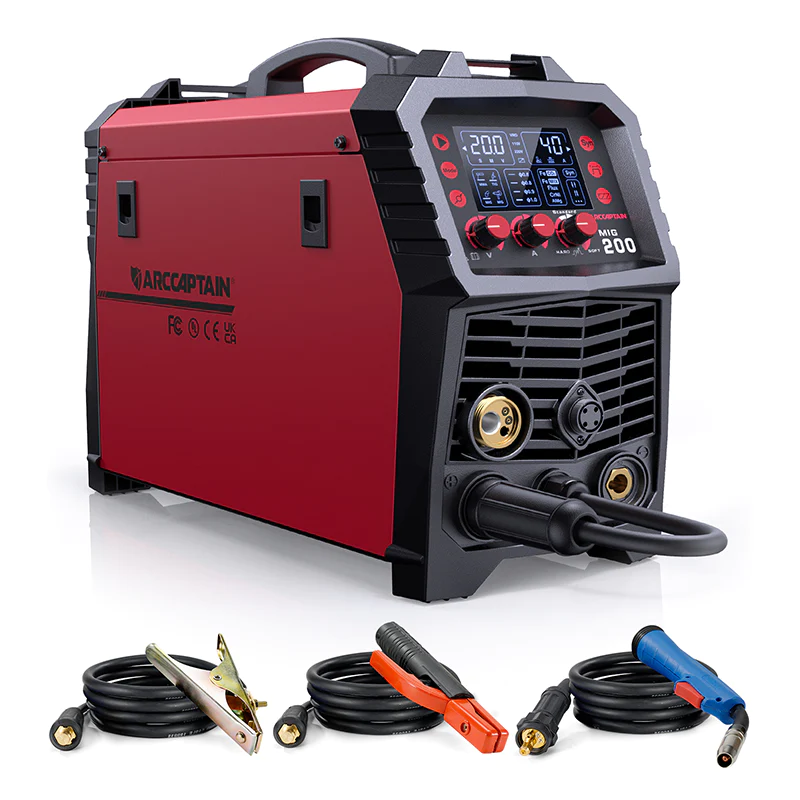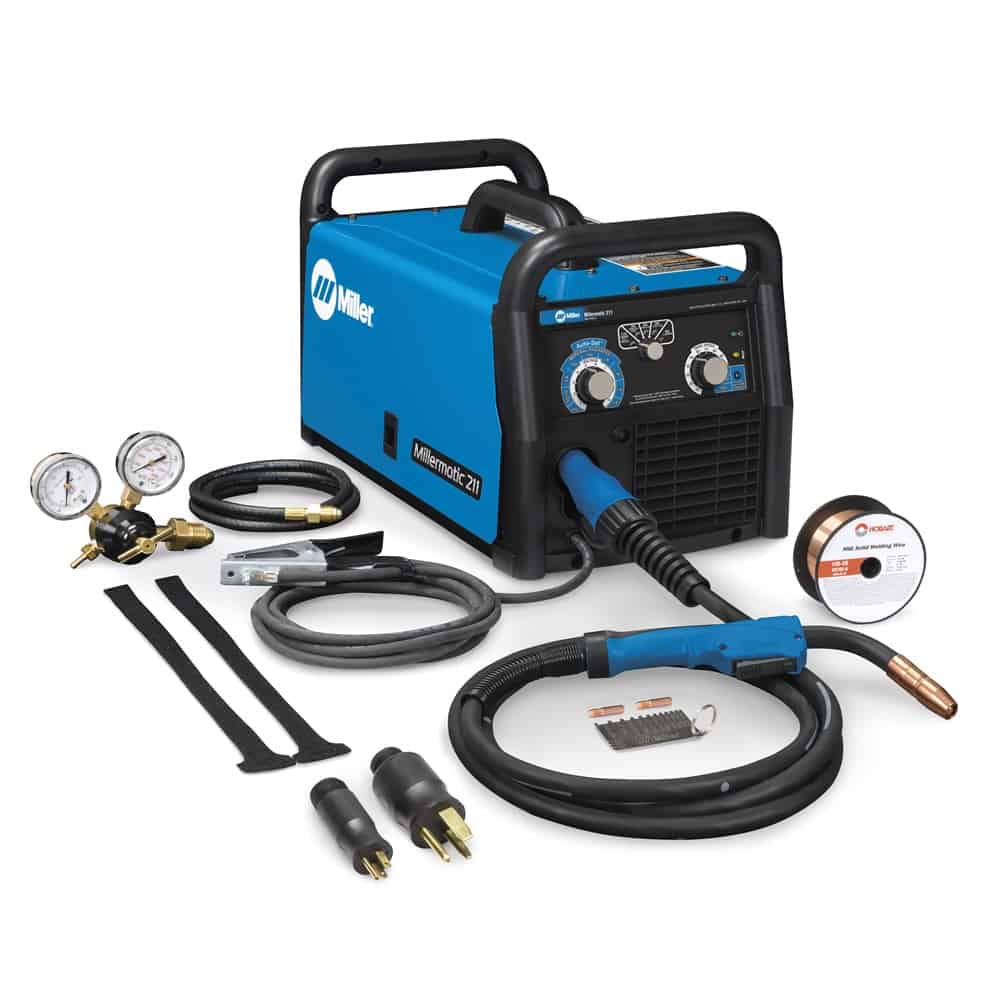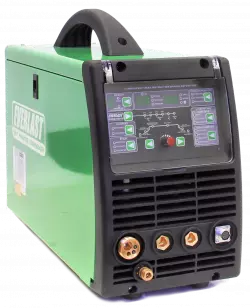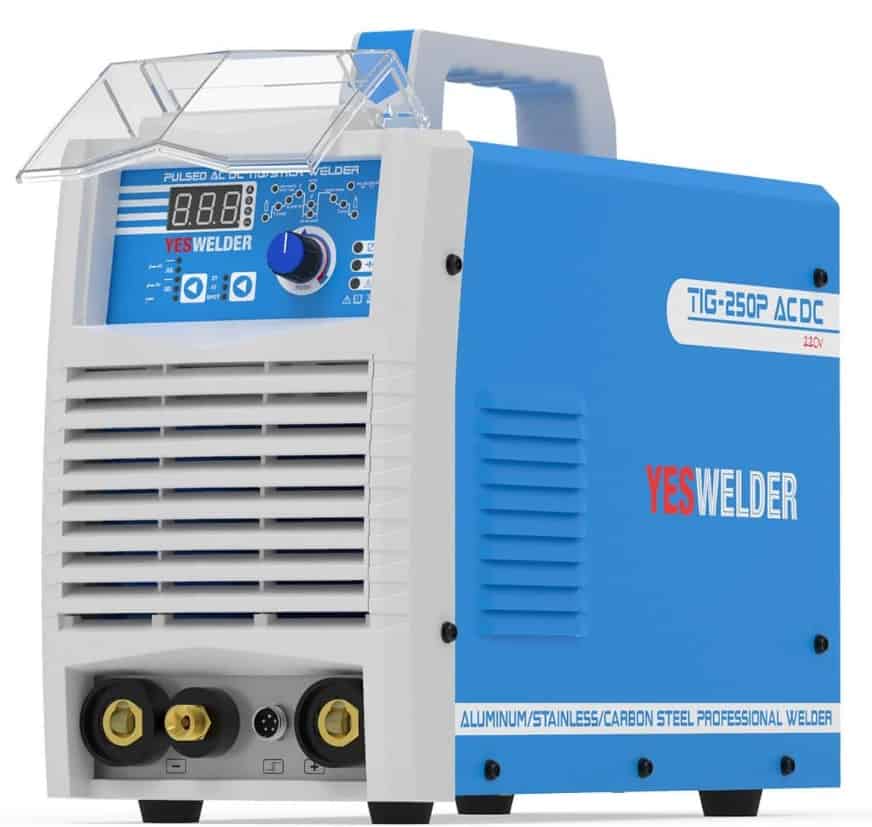Do you need something that has a bigger kick than a small 110V welder? The projects that you are working on are getting a bit more difficult and your old machine seems not to be pulling the weight. Maybe it’s time to go for a more powerful machine and get yourself a 220v MIG welder.
Most of us use MIG welders for various types of work.
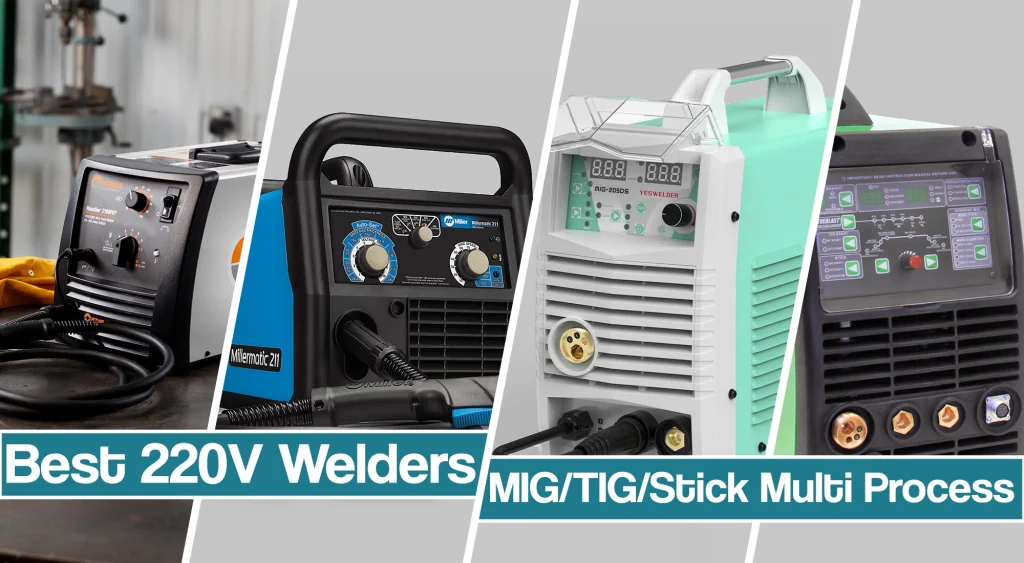
I myself think of the Metal Inert Gas welding process as my go-to choice when I work. But I also know that a suitable welder does half the work for you. Seeing that most fellow welders are in a pickle when choosing the right tool for the job, I decided to take a look at some prime MIG welding machines and devise a list of MIG welder reviews. I went through and compared a lot of models to come up with the best 220v MIG welders.
Oh, and I also included a buyer’s guide so you know what to look for yourself and see how I came up with my list.
Hopefully, you find this info useful when getting your new baby for the job.
Best 220v Welders Comparison Table
| Welder Image | Name | Voltage inputs | Output Current Type | Amperage Output | Duty cycle | Welding Process | Check Price |
|---|---|---|---|---|---|---|---|
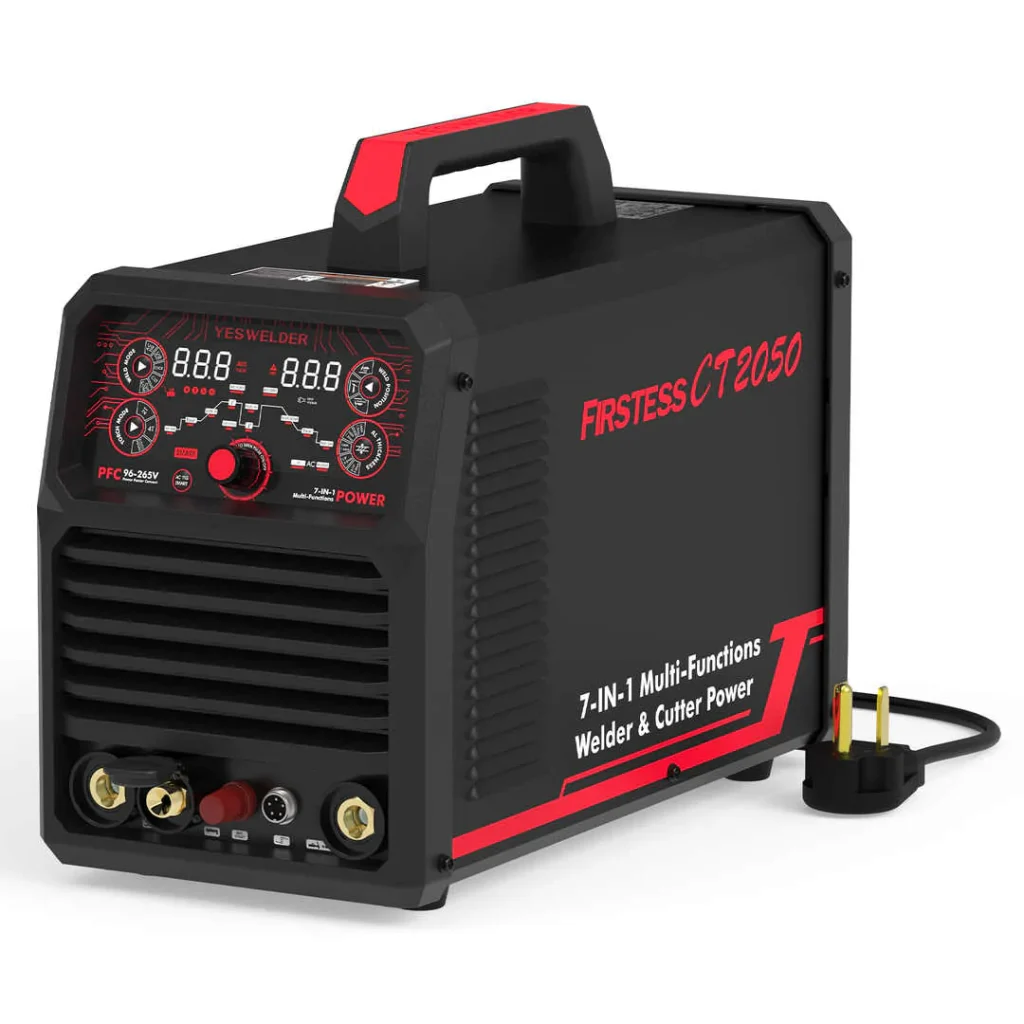 | YesWelder CT2050 7-in-1 Welder And Cutter Get 10% Off With Coupon: “-10% WELDPROS” | 110/220 V | AC/DC | TIG 5-200A, STICK 10-200A, CUT 12-45A | TIG - 100% at 200 amps Cut - 100% at 45 amps Stick - 60% at 200 amps | TIG/Stick Pulsed TIG Plasma Cutting | Check Current Price YesWelder |
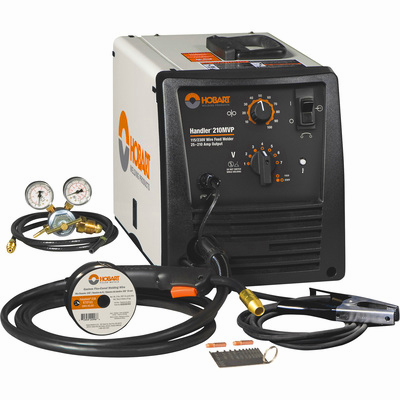 | Hobart 500553 Handler 210 MVP | 110/115/120 V, 220/230/240 V. 60 Hz | DC | 25-150A | 115 V, 90A @ 20% duty cycle./230V, 150A @ 30% duty cycle | MIG/Flux Core | Check Current Price Northern Tool |
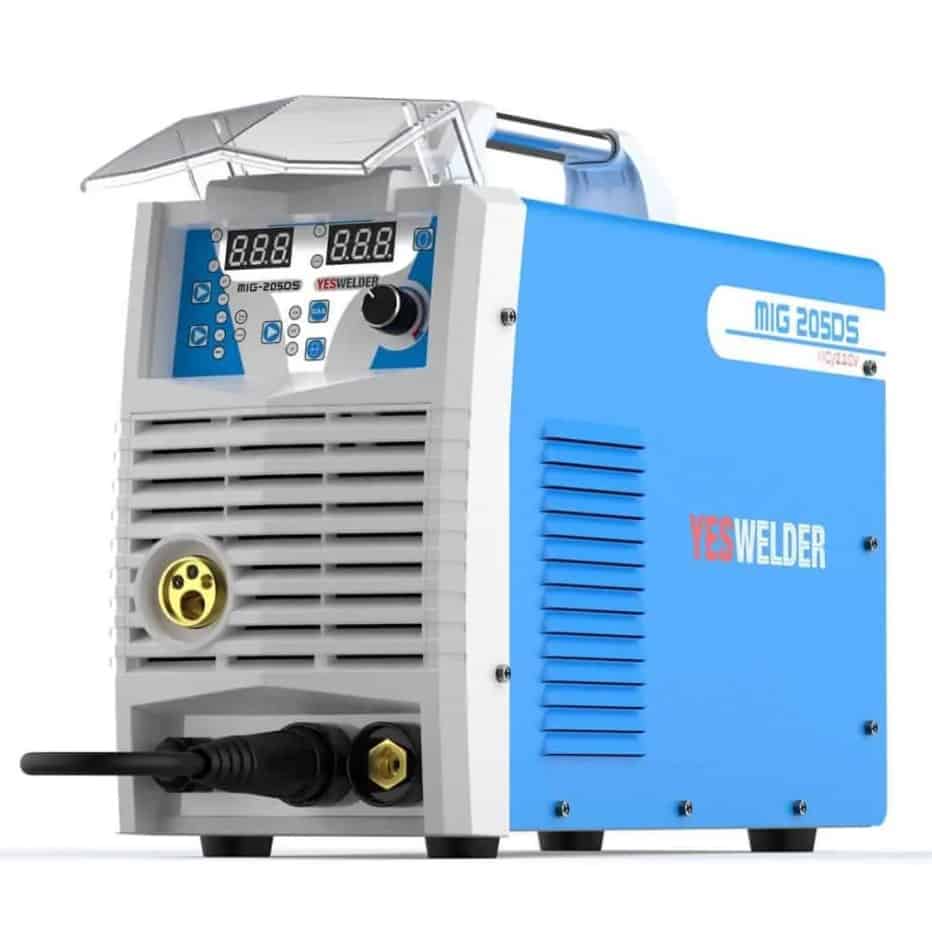
| YesWelder MIG-205DS Get 10% Off With Coupon: “-10% WELDPROS” | 120v/220v | DC | 110v: 30-160A 220v: 30-200A | 110v [160A @ 60%] 220v [200A @ 60%] | MIG/DC TIG, DC Stick | Check Current Price YesWelder |
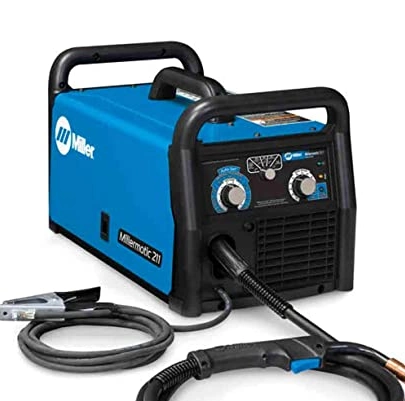 | Millermatic 211 MILLER ELECTRIC MIG Welder | 110/115/120 V – 220/230/240 V | DC | 30-230A | 50 A at 21.5 VDC, 40% duty cycle (240V), 115 A at 19.8 VDC, 20% duty cycle (120V) | MIG/Flux Core | Check Current Price Amazon |
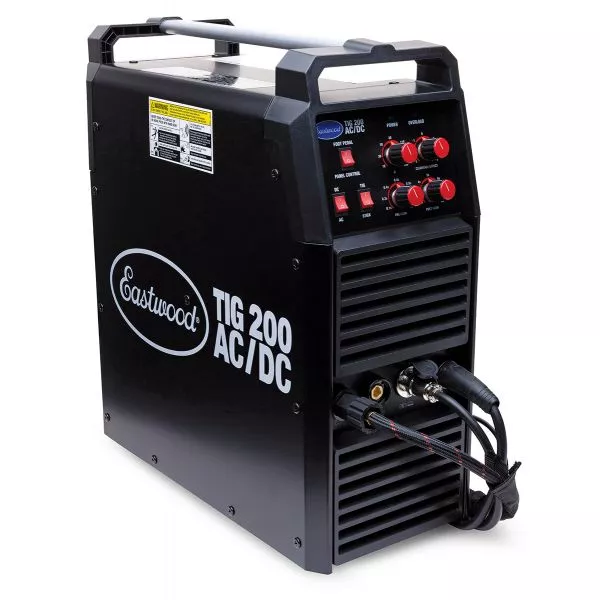 | Eastwood TIG200 AC/DC | 110/220 V, 60 Hz. | AC/DC | TIG: 10-190 | 190 A @ duty cycle 60% | TIG/Stick | Check Current Price Eastwood |
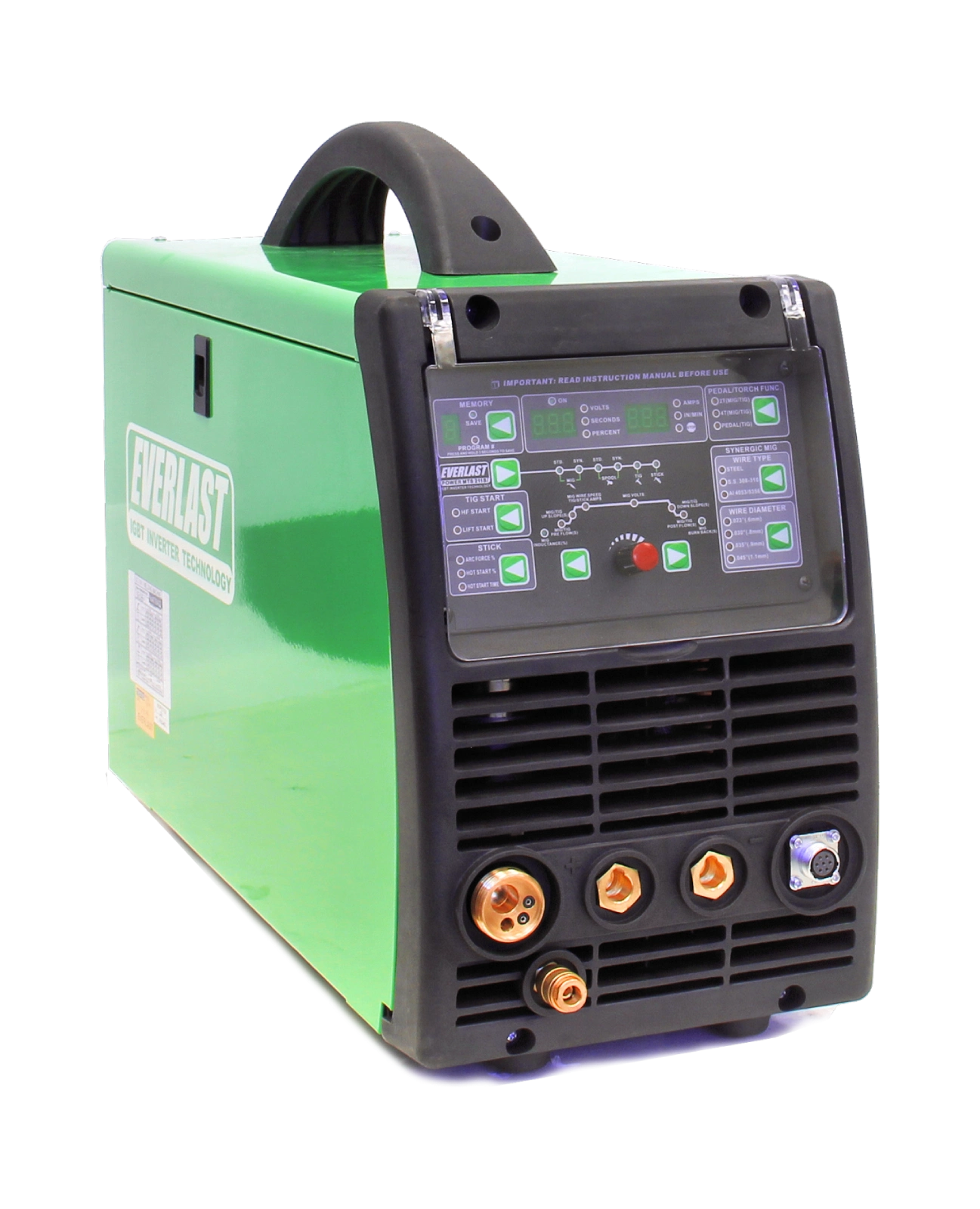 | Everlast Power Equipment PowerMTS 211Si MIG TIG Stick 200amp | 120/240 | DC | MIG and TIG:240V @ 210A, 120V @ 125A, Stick: 240V @ 175A | MIG 160A/22V @ 60% Duty Cycle TIG 160A/16.4V @ 60% Duty Cycle Stick 130A/25.2V @ 60 % Duty Cycle | MIG/TIG/Stick | Check Current Price Amazon |
Best 220v Welders Reviews
When a 110v is not enough, it is where a 220v has to come into play. Stronger welders are needed for thicker materials, and the 220v ones are usually meant for heavy-duty projects. It works best when you are able to use both types in sync, so you can weld interchangeably. For that, a multi-process welder comes as the best choice.
Even with thorough research, you might find it hard to pick the best 220v MIG welder. But that is because you have to choose one that fits your needs. I have checked many 220V MIG welder reviews and comprised a list that is in my opinion the most suitable for both beginner welder needs but could satisfy some with a more refined taste.
1. YesWelder CT2050 – All-in-one 220V Welder and Cutter
While we tried to balance our list of best 220v welders to include MIG, TIG, and multi-process machines, the YesWelder CT2050 is somewhat different. This is an all-in-one AC/DC TIG, Pulsed TIG, Stick, and plasma cutting. At first glance, CT2050 leaves an impression of a well-built and sturdy machine, and yes, the practice confirmed that.
YesWelder CT2050 is a dual voltage welder, but it introduces a Power Factor Correction (PFC) technology that allows it to work with outstanding 96-265V.
As a result, you can use the welder on various occasions, as PFC technology maximizes real power drawn from the grid supply.
Regarding the power, CT2050 is a more than capable 220V welder and cutter with a rated output of 200 amps with a 60% duty cycle. In addition, plasma cutting is rated at 45 amps, which is more than suitable to cut or weld thicker metals. In addition, there are AC TIG and Pulsed TIG options, so the welder is more than suitable to weld aluminum.
The only, and for someone, a most significant drawback is that there is no MIG welding. Therefore, I’d recommend this welder to more experienced users that base their hobby or small business on TIG welding and plasma cutting. If MIG welding is a must-have for you, you can look for YesWelder MP200, a multi-process welder and cutter with the GMAW option.
I disliked the bulky WP26 torch, which was also included with TIG-250P. I would prefer a flex-head, smaller torch for more delicate work, but that’s my personal preference. In addition, with 61 lbs, the machine is somewhat heavier than the rest of the YesWelder lineup.
Get 10% Off With Coupon: “-10% WELDPROS”
Pros & Cons Summarized
Pros
- All-in-one welder and cutter
- PFC technology for wide 96-265V input
- AC/DC TIG, pulsed TIG, and plasma cutting
- 200 amp output with 100% duty cycle
- Suitable for aluminum and other delicate metals
- Decent accessories and package value
Cons
- No MIG welding option
- TIG torch is bulky
Specifications
- Process: TIG welder (GTAW) AC/DC TIG, Pulsed TIG, Stick Plasma cutting
- Weld Thickness: 24 ga. – 1/4 in.
- Weldable Materials: Steel, Stainless Steel, Aluminum.
- Input Voltage: 96-256V 50/60 Hz
- Input Phase: 1-phase
- Current: AC and DC current
- Amperage: TIG 5-200A, CUT 12-45A @ 220V
- Rated Output: 100% at 200 amps
- Max Clean Cut Thickness: 1 3/16″ @ 220V; 25/32″ @110V
- Weight: 61 lbs
2. Hobart Handler 210 MVP 220v MIG Welder
The Hobart Handler 210 MVP is one of the welder’s favorite MIG welding machines, as it offers a wider amperage range, high-quality components, and ease of use. Even though this is not the cheapest MIG machine out there, it comes at a great price, given its components, reliability, and reputation.
The amperage range is maxed out at 210 amps, with a wide wire feed speed from 40 IPM to 770 IPM.
The wire feed speed adjustment is infinite, while the voltage is divided into seven taps. Still, you can easily control the welding process. With the given power, you can use Handler 210 MVP to weld 24 ga. up to 3/8 in. mild steel.
What I like about this one is that it is easy to set up. That’s what makes it one of the best MIG welders for beginners and seasoned users. What distinguishes Hobart Handler 210 MVP from other Hobart machines in the Handler series is the multi-voltage plug (MVP). As a result, this is a dual voltage MIG welder you can run off both 110V and 220V supply.
However, the MIG welder Hobart Handler is rather a stationary machine. With a weight of 79 lbs, you can break a sweat if you try to move it around the garage or workshop without ending the cart. Nevertheless, the weight results from transformer technology that offers a very smooth and consistent arc and does not give off so much spatter as other MIG welder machine does.
Learn more about this Hobart welder.
Pros & Cons Summarized
Pros
- Welding is smooth, arc quality control
- Cost-effective, multi position voltage control
- The internal fan cooling system
- Industrial cast aluminum drive system
- Includes dual gauge regulator, power cord, and ground clamp cable
- Spool gun compatible
- Drive rolls with 3 grooves for welding wires, 2 for gas, and 1 for flux core wire
Cons
- Expensive
- Work cable can be short
- It’s not very light
Specifications
- Process: Flux Cored (FCAW), MIG (GMAW)
- Weld Thickness: Mild Steel – 1/4 inches to 3/8 inches
- Weldable Materials: Steel, Aluminum, Stainless Steel
- Input Voltage:110/115/120 V, 220/230/240 V. 60 Hz
- Input Phase: 1-phase
- Current: DC only
- Amperage: 115 V: 25–140A, 230 V: 25–210A
- Rated Output: 115 V, 90A @ 20% duty cycle/230V, 150A @ 30% duty cycle
- Wire Feed Speed: 40 IPM – 770 IPM
- Weight: 79 lbs.
3. Arccaptain MIG200 – Budget-friendly 220V Welder
The latest machine from Arccaptain, the MIG200, is a versatile and feature-packed multi-process welder aimed at DIY lovers, hobbyists, and small shop owners. It is a 6-in-1 welder, offering MIG/Flux core, DC TIG, and Stick welding capabilities.
Even though MIG200 is a dual voltage welder capable of running off both 110/220V, it shows the best results when plugged into 220V. That is why it is on our list of the best 220V welders. At 220V, it is capable of outputting a maximum of 200 amps. That’s more than enough for your everyday home projects.
There is always a doubt among fellow welders when discussing off-shore affordable welders like Arccaptain MIG200, but this one seems like a well-built and sturdy machine. It is also tested in simulated harsh conditions, including condensation, flipping, or dust, and rated with the IP21S protection standard. These are all conditions you can meet in your garage or small shop, but it is not an industrial-grade, outdoor machine like Lincoln Power Wave welders that can withstand rain, snow, or falling out of the truck.
I liked the MIG welding function with synergic controls that will allow beginners to get the hang of the welder. A full metal wire drive system ensures smooth feed without bird nesting or tangling. In addition, you get advanced controls such as inductance, post-flow/pre-flow, and burn-back.
Stick welding is also covered by nice features you usually see at much more expensive arc welders. For example, you can adjust arc force, hot start, or anti-stick to get an easy arc start and consistent results across the weld.
However, TIG welding is rather basic. MIG200 is a DC-only welder, meaning you cannot TIG weld aluminum. To weld aluminum, you will have to buy an extra spool gun. In addition, you don’t get a TIG torch in the package, so you will have to spend extra bucks to get everything out of it.
Nonetheless, you still get excellent value out of this 220V multi-process welder. It also has built-in overload over current, temperature, and voltage protection that kicks in to protect the internal components. In addition, the welder is covered by a two-year warranty, which you rarely see among budget-friendly manufacturers.
Learn more about this Arcaptain welding machine.
15% Discount Code: BLACKFRIDAY002
Pros & Cons Summarized
Pros
- Great value for the money spent
- Maximum power at 220V
- MIG/Flux-core/Stick and TIG capabilities
- High duty cycle
- Advanced features and capabilities
- Synergic MIG for beginners
- Protection systems
- Tested in harsh environments
- 2-year warranty
Cons
- You don’t get a TIG torch
- Cannot TIG weld aluminum
- Spool gun for MIG aluminum welding is sold separately
Specifications
- Process: Flux Cored (FCAW), MIG (GMAW), Stick, Lift TIG
- Weld Thickness: Mild Steel – 1/4 inches to 3/8 inches
- Weldable Materials: Steel, Aluminum, Stainless Steel
- Input Voltage:110/220 V 60 Hz
- Input Phase: 1-phase
- Current: DC only
- Amperage: 110 V: 20–135A, 220 V: 20–200A
- Rated Output: 115 V, 135A @ 60% duty cycle/230V, 200A @ 60% duty cycle
- Welder Protection Rating: IP21S
- Weight: 28.2 lbs.
3. AHP AlphaMIG 190MP – Durable 220V Welder
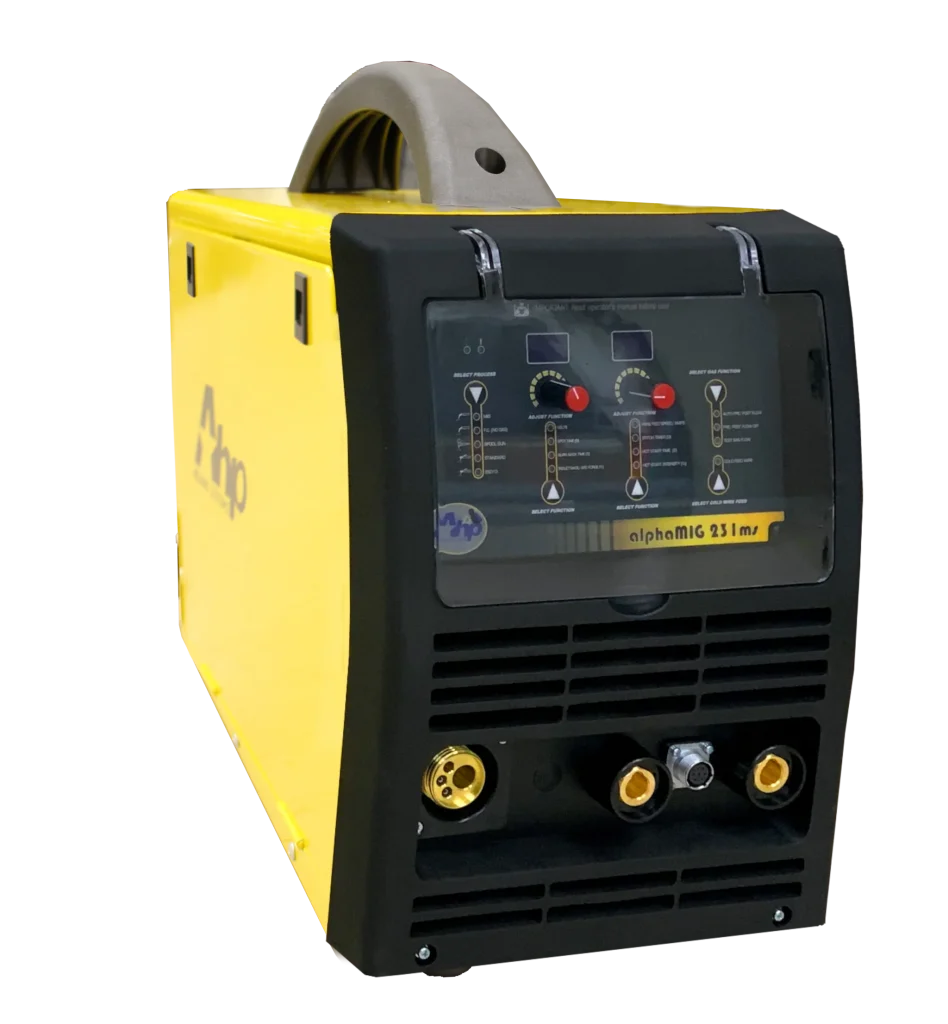
AHP is one of the newer welding equipment manufacturers, but their machines quickly gained popularity due to good results and reasonable pricing. Their AlphaMIG 190 MP is a new multi-process welder rated at up to 200 amps, capable of working with DC MIG, DC TIG, and Stick. With a dual voltage input, this is a perfect all-around machine for any garage or small fabrication shop.
The AHP AlphaMIG 190 MP leaves a first impression of the pretty robust and well-built welder, designed to withstand everyday use, unlike some cheap units on the market.
I also loved the fact that you get everything you need to weld straight out of the box, including the MIG torch, Stick electrode holder, and TIG torch. Many brand-name manufacturers started dropping TIG torches out of the original package, so you have to buy them separately, which is not the case here. The control panel is highly intuitive, so it takes no time to set up everything and start welding, even if you are a beginner.
With 200 amps of MIG power, you can easily weld 1/4 “-3/8” thick metals. The ALPHAMIG 190 MP is spool gun ready, so with an optional spool gun, you can weld aluminum. Meanwhile, the unit offers a DC TIG, which means you cannot TIG weld aluminum with it, and the AC/DC function with multi-process welders is still reserved for high-end units. However, high-frequency TIG is more than good, and at a maximum output of 180A for DC TIG, you can deal with various steel thicknesses. The DC Stick function operates standard fabrication rods like E7014, E6013, and E7018. It delivers smooth, quiet welds with minimal amounts of spatter and noise.
Overall, AHP ALPHAMIG 190 MP is a highly versatile multi-process welder for everyday use. This welder is durable and capable of welding various metal thicknesses at 110 and 220V. Many consider that welder performs remarkably well, especially given the price point, and at 220V, it shows its true potential, which is why we highlighted it in this list.
Pros & Cons Summarized
Pros
- Highly versatile
- Robust and durable build with excellent build quality
- Excellent welding capability with smooth arc and good penetration
- Accessories are included in the box
- Spool gun ready
- High-frequency TIG start
- Easy to start Stick
Cons
- Cannot TIG weld aluminum
- Somewhat low duty cycle
- Some disliked lead length
Specifications
- Processes: DC MIG, DC TIG, DC Stick
- Input Voltage: 120/240V 50/60Hz
- OCV: 70V
- Output Range MIG 120V: 30-200A, TIG 10-180, Stick 20-160A
- Duty Cycle Rating 120V: 25% @ 120A/20.0V
- Duty Cycle Rating 240V: 25% @ 180A/23V
- Start Type: HF, Lift with remote, Lift
- Output Range 120V: 10A-125A/10.4V-15V
- Duty Cycle Rating 120V: 25% @ Maximum output (Rated @ 40°C)
- Weight: 58.9 pounds
4. The YesWelder MIG-205DS MIG/LiftTIG/ARC 3 In 1
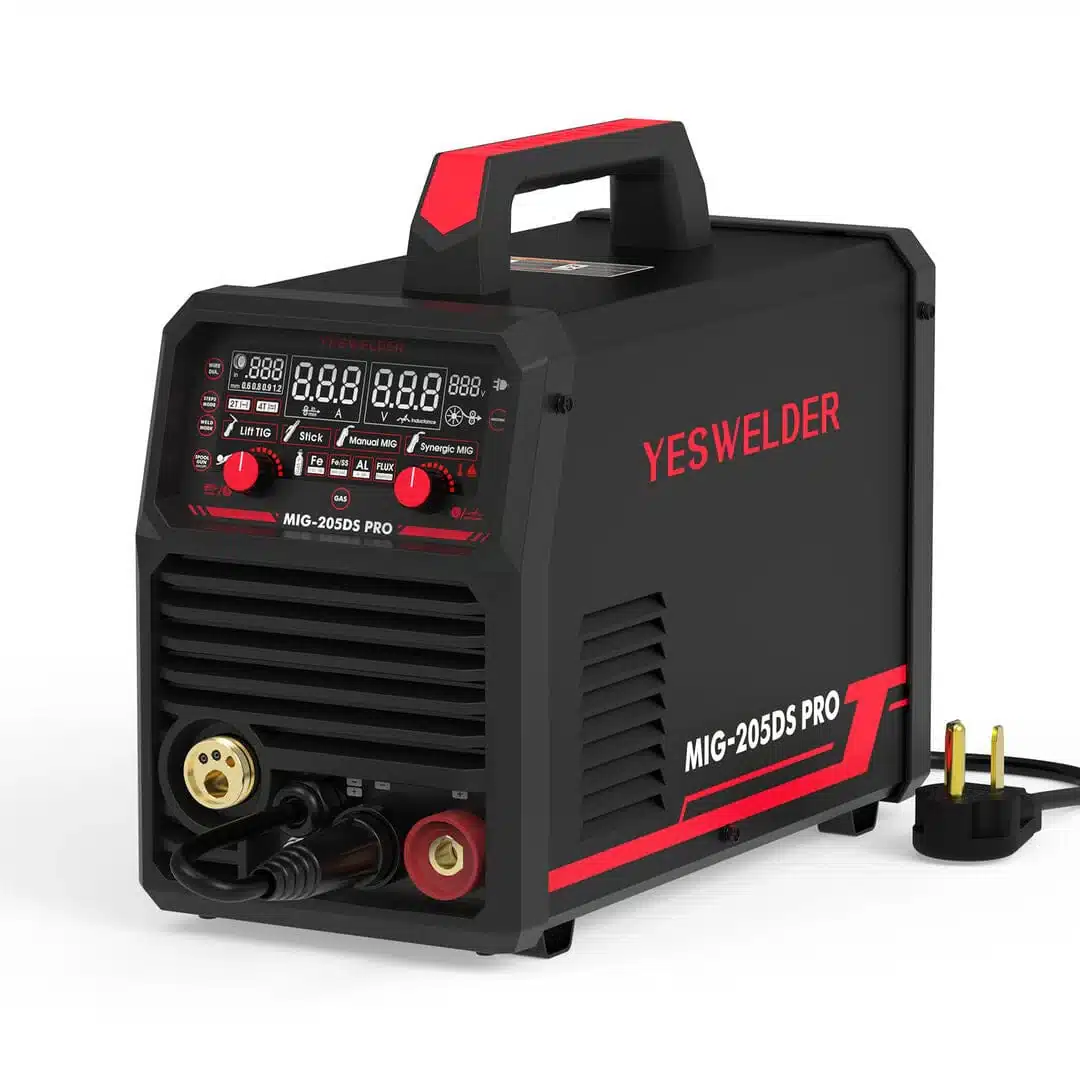
Reading the many internet reviews, many welders agree that YesWelder MIG-205DS is the best welder for the money. It is a durable multi-process machine that offers high value at a suitable price. This 220V MIG welder can do Stick and MIG Flux Core welding but can be extended with an added TIG torch so it can be used for Lift Arc TIG welding.
MIG-205DS is a dual-voltage machine, but due to limited power at 110V, we highlighted it as a great 220V welder.
At 220V, the machine is capable of outputting 205 amps. With the given power, you can weld mild steel up to 3/4 in. I was also impressed with a full metal drive system, which you rarely see in this price range, as many cheap Harbor Freight welders use plastic that falls apart soon enough.
The Synergy settings make this machine extremely beginner-friendly. To start welding, you will have to input the material thickness and wire diameter, and the machine will automatically adjust the wire feed and voltage.
IGBT inverter technology makes this welder compact, efficient and lightweight. That’s why I recommend it for remote work, as you can carry it around or easily change the plug when needed. However, the biggest drawback is the inability to MIG weld aluminum. This welder is not compatible with spool gun, so to weld aluminum, you should look for YesWelder MIG Pro, or newer YesWelder YWM-200 Double Pulse Aluminum Welder
Read the extended review we made about this YesWelder machine.
Pros & Cons Summarized
Pros
- Very Affordable
- A lot of useful features, good for MIG, TIG, and stick
- Really high 110v and 220v duty cycles
- Sturdy build
- Lift arc start for TIG
- Dual voltage welder
- IGBT inverter technology
- Wire feed system Brass-to-brass gun connection
Cons
- TIG torch is not included
- Not suitable for MIG aluminum welding
Specifications
- Process: MIG (GMAW), DC TIG (GTAW), DC Stick (SMAW)
- Weld Thickness: Mild Steel up to 3/4 in
- Weldable Materials: Steel, Stainless Steel
- Input Voltage: 110/220V, 60 Hz
- Input Phase: 1-phase
- Current: DC only
- Amperage: 110V: 30 – 160 A, 220V: 30 – 200 A
- Rated Output: MIG -110v (160A @ 60%) 220v (200A @ 60%); TIG & Stick – 110v (140A @ 60%) 220v (180A@ 60%)
- Maximum Wire Feed Speed: 590 IPM
- Weight: 33 lbs
5. Millermatic 211 MILLER ELECTRIC MIG Welder,120/240VAC
I would assess the Multimatic 211 as the best welder suitable for small workshops, DIY projects, farm projects, and metal artists. Actually, I consider it to be perfectly suitable for both beginner and experienced welders.
The beginners will appreciate the auto-set feature and the quick select drive roll system that allows them to set things up fast and start working without wasting too much time or effort. It does have multiple voltage capabilities and can be used for both 120V and 240V input voltage outlets.
When plugged into a 220V outlet, Millermatic 211 can output up to 230 amps, allowing you to weld up to 3/8 in. mild steel. Compared to YesWelder MIG welder, Millermatic is spool gun compatible, meaning you can weld aluminum. With inverter technology, you also get more power, less weight, and better arc performance.
In my opinion, Miller really tries their best to set the stage for ultimate welding machine quality, but this does come at a price. This is a brand-name welder, which is significantly pricier than the YesWelder machines we listed.
Also, if you wish to weld aluminum, you need to get a spool gun, which is an added expense. The ground clamp looks a bit flimsy for my taste as well. But I do love the cooling system, which improves the duty cycle, and the package content is pretty vast, as you get a sample spool of wire, gas regulator, and everything to weld straight out of the box, of course, excluding the shielding gas.
Pros & Cons Summarized
Pros
- Inverter technology device
- Suitable for welding steel, aluminum, stainless steel
- Auto spool gun detect
- Aluminum wire drive
- Easy start arc function, and precise welding chart suitable beginner welders
- Argon regulator (Argon/CO2) with gas hose
Cons
- Expensive
- MIG gun can be troublesome
Specifications
- Process: MIG and Flux Core (FCAW)(GMAW)
- Weld Thickness: Mild Steel – 24 GA to 3/8 in
- Weldable Materials: Aluminum, Steel, Mild Steel
- Input Voltage: 110/115/120 V – 220/230/240 V
- Input Phase: 1-phase
- Current: DC only
- Amperage: 30 A – 230 A
- Rated Output: 150 A at 21.5 VDC, 40% duty cycle (240V),115 A at 19.8 VDC, 20% duty cycle (120V)
- Wire Feed Speed: 60 – 600 IPM
- Weight: 38 pounds
6. Eastwood TIG 200 AC/DC
If you are into the auto body or car restoration business, there are small chances you haven’t heard about Eastwood. Eastwood makes some outstanding welders for car repair and restoration enthusiasts, but the applications will extend the use. In this article, we highlighted a TIG 200 AC/DC machine due to its versatility, features, and reasonable price.
Eastwood TIG 200 AC/DC is a budget-friendly TIG welder rated at 190 amps. The design is somewhat more traditional compared to YesWelder TIG welder, but it offers fewer controls.
Nonetheless, at 220V input, the welder can join metals up to 1/4″ thick, but you will need a 30-amp circuit breaker. The high-duty cycle of 60% rated at the max output will help you weld longer.
One thing that I especially liked was the high-quality accessories. The latest version of TIG 200 AC/DC brings an improved rocker-style foot pedal and gas regulator. The WP17 torch is more comfortable and lighter compared to YesWelder’s WP26, and the pedal seems sturdy.
The price of Eastwood AC/DC 200 TIG welder certainly helped us put it on our list, but keep in mind that there are more advanced machines. The Digital TIG 200 AC/DC model from Eastwood offers significantly more control options, such as pulse, balance, upslope, and downslope options, which are similar to YesWelder TIG 250P.
I found a short 6 ft power chord as the biggest con of Eastwood TIG 200 AC/DC. However, short cords are proof that the welder is designed for garage work, not for field projects and jobs.
Pros & Cons Summarized
Pros
- Great value for the money spent
- Dual voltage control
- Suitable for aluminum welding
- Inverter Squarewave AC feature
- High-quality accessories
- High duty cycle
Cons
- Short power chord
- Somewhat limited controls
Specifications
- Process: TIG welder(GTAW) and Stick welder (SMAW)
- Weld Thickness: 24 ga. – 1/4 in.
- Weldable Materials: Steel, Stainless Steel, Aluminum.
- Input Voltage: 110v/220 V, 60 Hz.
- Input Phase: 1-phase
- Current: AC and DC current
- Amperage: TIG 10 – 190 A.
- Rated Output: 190 A @ duty cycle 60%
- Weight: 35 lbs
7. Everlast 211si MTS Welder
When you compare the Everlast 211si MTS welder with others, what jumps off the page is that it can do multiple processes. So besides MIG welding, it can be used for TIG and Stick and used for different kinds of materials of various thicknesses.
I really liked how the control board works as it clearly shows you the amperage range and the wire feed speed control. Manual settings are also there if you want to go into details. However, beginners will certainly appreciate the synergic control, where the welder automatically adjusts the wire feed and voltage.
The Everlast MTS211si at 240 volts can output 200 amps, which is suitable from 20 gauge sheet metal up to 1/4″ steel. I liked the excellent stick welding arc control and adjustable dig, but TIG and MIG are also just fine.
The build quality is very nice, and you are getting a durable machine that is meant to last. However, too many settings can make things a bit confusing for a novice. The front panel of the 211Si MTS definitely looked intimidating when I unboxed it for the first time, but having enough options to control your entire welding process is always a good thing. Therefore, it might take you some time to get used to everything Everlast MTS 211Si offers.
While you get everything you need to weld straight out of the box, certain accessories are so, so. The MIG gun doesn’t use standardized Tweco-style consumables, but you will be more than suitable with Euro-style fittings and consumables.
Pros & Cons Summarized
Pros
- Lift and high frequency start
- Silent work, no noise pollution, not in audio range
- Synergic settings
- heat protection system
- Decent accessories included
- Good controls
Cons
- The instruction manual can be better
- Chart not included, you have to figure out settings on your own
- The gas hose can leak
Specifications
- Process: FCAW, GMAW, SMAW
- Weld Thickness: 24 gauge to 1/4″
- Weldable Materials: Welds Steel, Stainless-Steel, Aluminum
- Input Voltage: 120/240V
- Input Phase: 1-phase
- Current: DC current
- Amperage: MIG and TIG 240V @ 210A, 120V @ 125A, Stick 240V @ 175A
- Rated Output: MIG & TIG 160A/22V @ 60% Duty Cycle; Stick 130A/25.2V @ 60 % Duty Cycle
- Maximum Wire Feed Speed: 600 IPM
- Weight: 55 pounds
8. YesWelder TIG 250P ACDC
From my experience, the YesWelder TIG 250P is a machine aimed at somewhat more experienced welders, but it is often used by beginners due to its ease of use.
With its multi capabilities, you can do AC pulse TIG, DC TIG, DC Pulse TIG, DC Flux-cored wire MMA, and argon arc welding. These features are extremely useful when TIG welding aluminum, and having them all in one machine is really beneficial.
If you decide to invest in this budget-friendly machine, you get a High-Frequency start, upslope and downslope settings, pre and post-flow control, and a low 5 amp start.
As a result, you can get perfect control over the entire welding process, which is essential when welding exotic and thin materials such as aluminum sheets.
The best part about YesWelder TIG-250P is that you don’t have to break the bank. In addition, you get quite a capable machine rated at 250 amps. The 220v welder even packs in a TIG pedal and a decent duty cycle of 60% at maximum output. However, some may dislike the included WP26 heavy-duty torch, which feels bulky. Even though it is made to withstand high amps, it can feel uncomfortable, especially when working in cramped spaces.
The welding machine is a bit on the expensive side if you are a hobbyist, but certainly not as the machines with the pulse and AC/DC options such as Lincoln Squarewave or Miller Diversion. The advanced features could make things a bit confusing for a beginner, but this might be a perfect machine to practice high-end TIG welding.
Pros & Cons Summarized
Pros
- You can TIG weld with a fully adjustable pulse rate
- High-Frequency Start, IGBT value welder
- It has controls for start and end amps
- AC balance
- Squarewave AC feature
- Easy to set up, quality welds
- Very good Aluminum TIG welder
- Comes with stick electrode holder, gas hose, brush and foot pedal
Cons
- The torch can feel bulky and uncomfortable
Specifications
- Process: TIG welder(GTAW) and Stick welder (SMAW)
- Weld Thickness: Steel – 24 ga. – 3/8 in.
- Weldable Materials: Steel, Stainless Steel, Aluminum.
- Input Voltage: 220 V, 60 Hz.
- Input Phase: 1-phase
- Current: AC and DC current
- Amperage: TIG 5 A – 200 A.
- Rated Output: 250 A @ duty cycle 60%
- Weight: 35 lbs
Buying Guide to the Best 220V Welders
Now take a look at some factors that I used in determining my choices when it comes to 220V MIG welders. Every person is going to need a welding machine for their own personal purpose.
From my experience, the factors below should have the highest impact on your buying choice.
How Portable It Is?
Portability should be considered based on where you plan to work. If you are only going to do work in a garage, the best MIG welder for the job is a stationary one. However, if you need to go out in the field, be sure to look for a lightweight option.
Besides the weight, I would also make sure the welder can operate on 110V if possible. I know that this is a guide for 220V machines but think about it. If you have to go out in the field and the 220V generator is not available there, it is helpful if your machine is dual voltage.
On another hand, if you don’t mind heavy machines you should think about a good cart to help you move it around.
Welder Quality and Price
Quality welders come with better internal hardware and wiring. They also have more quality components and expanded features and settings. But they also come at a greater price. If you are a beginner or are on a budget, you might consider a low-cost machine with adequate welding functions for your needs.
If I was buying my first welder today, I would look for the best quality to price ratio. Back in my day, there weren’t this many brands competing on the market. Today you have much more options and finding a perfect machine means hitting that sweet spot of features you need, quality your amount of work demands (if you weld 8h a day you will need a highly durable welder unlike if you are a hobbyist) and the budget you have.
This is a great video of a teardown and a commentary of what you get when you get a poor quality welder. It’s a long video, I’ve linked to the part when the teardown starts and you can kind of skip around and see all of the design flaws from poor capacitor choice to improper placement of elements on the circuit boards.
Multi-Amp Settings
A machine with multi-amp settings could help you manage your electricity bill. Having dual voltage allows you to switch whenever necessary and you also don’t have to work with the same amount of heat depending on the material.
Machines that allow for fine-tuning of amperage settings are always preferred. Especially if you do TIG welding or any welding with thin sheet metal.
Welding Power and Material Thickness
More power output means a greater ability to cut thicker materials. You need to determine the purpose of your MIG welder and the materials you are planning to work on. A hobbyist will probably not need to weld or cut more than ¼ and 1/16. But if you are going to work on thicker materials a 220V MIG welding machine is needed.
Take the type of metal into the account as well. Most people will weld mild steel but aluminum may require more or less power depending on the thickness.
Duty Cycle
A duty cycle measures how long your machine is capable of working without overheating. For instance, if a machine has a duty cycle of 60% it means that you can weld without interruptions for 6 minutes. If you need to work on bigger projects and for prolonged periods, a MIG welder with a better duty cycle is needed.
I find low duty cycle welders a bit frustrating but that is because I don’t work on small-scale jobs anymore. If you need to weld a whole day you should get a welder with a good duty cycle but if you are a garage DIY hobbyist then this shouldn’t concern you that much.
Ease of Use and Build Quality
Advanced features can sometimes make it difficult for inexperienced welders. They need to control the MIG welding process for proper work, so sometimes a simple unit can be more suitable.
It is better to get a rugged and sturdy machine, but such a welder may weigh more. Even though the construction quality is important, you will be sacrificing a bit on portability.
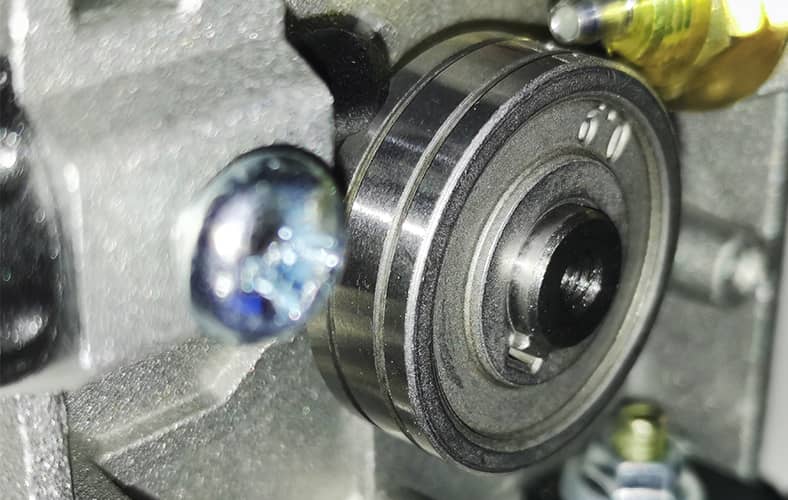
This is especially important if you are working in rough conditions and in tight spaces where the machine can’t be physically far away from the welding area. Sparks and molten drops can damage sensitive hobbyist level equipment and this goes for your whole welding arsenal, not just the machine (safety equipment and etc.).
One element that is particularly important is the MIG wire feed system. It should be made with a full metal drive and with a high precision build. The poor wire feed system can cause many problems down the road and not just bird nesting (basically tangling your MIG wire in a huge bush inside the machine).
Welding Processes
MIG welders are the most popular products on the market, as MIG welding is the most used type of process. But having a swiss-army knife of a welder machine could allow you to do Stick, TIG welding, and even flux core welding.
Multi-purpose welders can be a lifesaver sometimes. They are also a space saver. If you are working with a couple of processes then saving on valuable storage area can be helpful. Especially if you are a hobbyist and don’t have a big working area like welding shops do.
MIG/Fluxed-Cored Welding
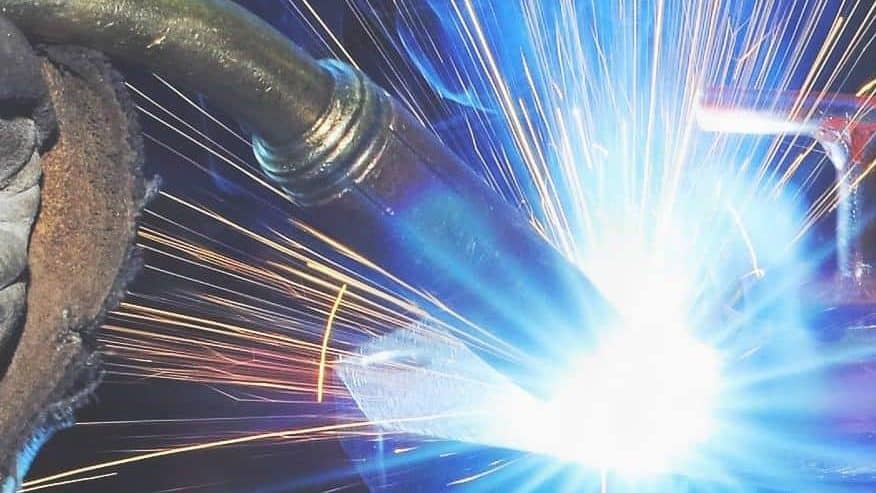
MIG welding is probably the easiest process to use, hence why it is so popular. The welding wire is fed through a gun and melted electrically with an electric arc to join the pieces of metal together.
You need to use an inert gas shield with these types of welders, but a flux-cored can be used instead.
The inert gas will prevent the weld from oxidizing, getting impurities and becoming porous. The flux core usually works without the shielding gas because the flux is in the core of the wire itself. As the wire melts so does the flux and It releases gasses necessary to protect the weld pool.
Stick Welding
Stick welding is one of the oldest welding techniques known to man. It can weld together most alloys and works well both indoors and outdoors. Arc welders are available in AC, DC or AC/DC, but AC is the most economical option. Unfortunately, stick limits you to welding 18 gauge, creates more spatter, and needs you to clean the finished weld.
Stick welding is more forgiving when it comes to dirty surfaces.
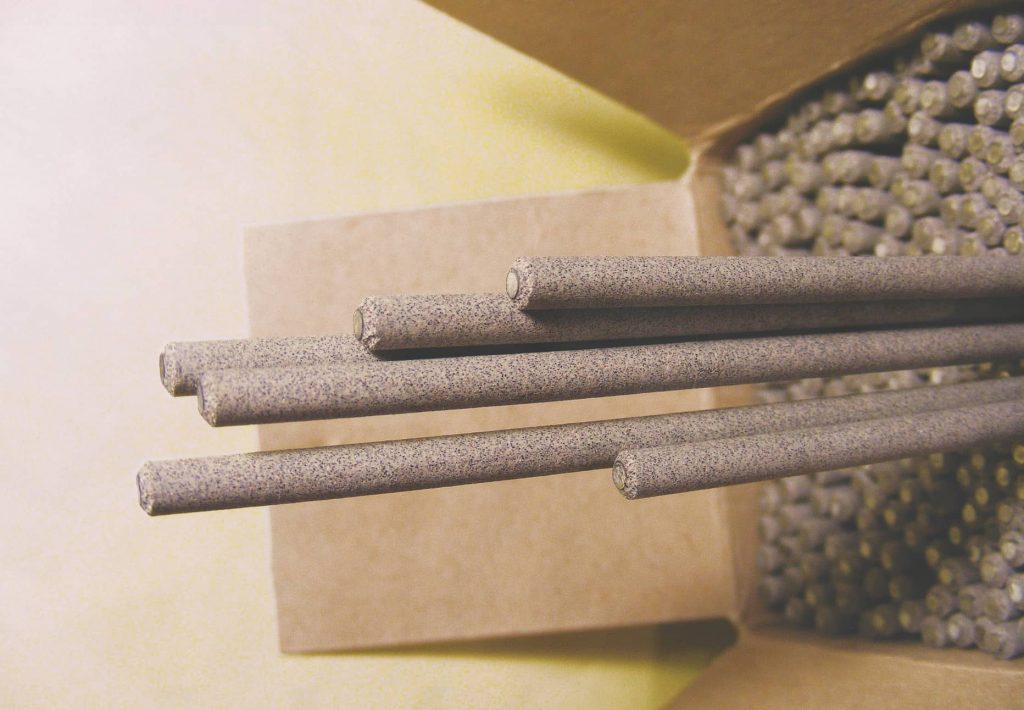
You should always clean the surface prior to welding but with stick welding, you can get away with some dirt and rust. This process is also a bit harder to learn than the MIG. It is not as straightforward because there are multiple factors at play.
TIG Welding
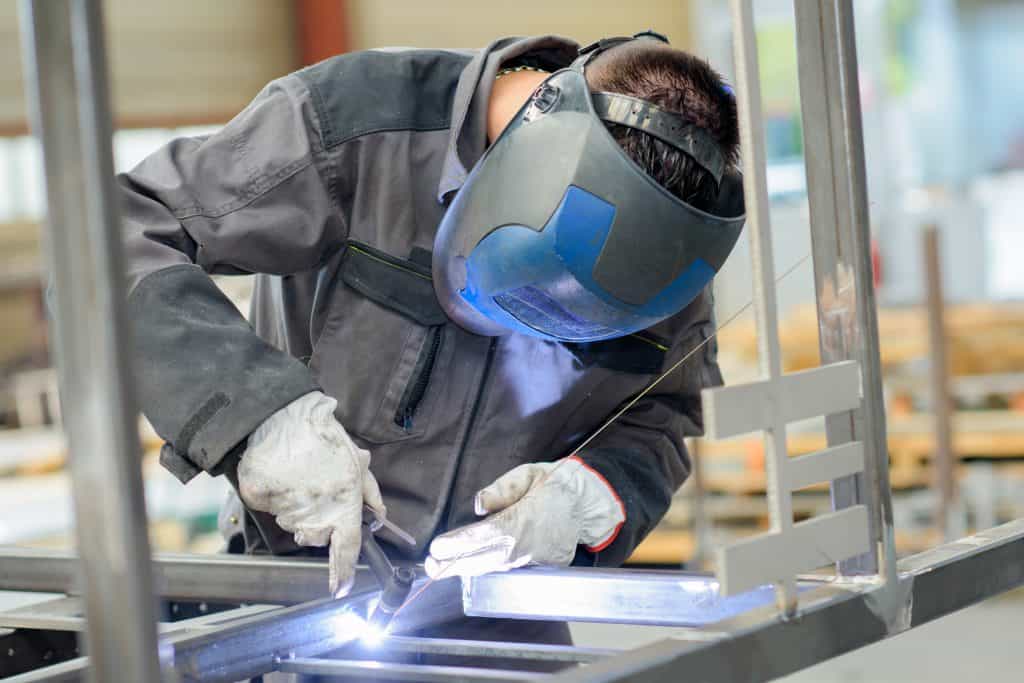
TIG is a very precise and clean method that creates strong and clean welds. With it, you can work on materials such as magnesium, stainless steel, aluminum, chrome alloy, copper, brass, and even gold. However, it is a far more complex process to learn and works a lot slower.
Working with TIG either means that you are doing professional work or you need to make small-scale precise welds on stainless steel.
Well, it can mean other things too but this is how it usually is. If you want to work on aluminum you will need an AC TIG capable machine but if you need to work on stainless or mild steel the DC will do.
Power Options
A welder usually comes at either 110V or 220V voltage. But there are ones that offer better voltage controls and output voltage settings. Basically, you are supposed to choose a welder based on the input power you need. There are those that come with a multi-voltage plug so you can use them interchangeably.
Warranty Options
Machines that have more than 1 year of warranty are good options. Anything lower than that is not. Of course, always look for one which has a longer warranty.
This is also something that should be determined based on the amount of work you will do. If you weld occasionally then a lower warranty will suffice but if you weld all day every day then the machine that is rated for 5 years or more will definitely last longer than the one that has a 1-year warranty.
Ventilation Exhaust
Be sure to check MSDS (Material Safety Data Sheet) for the materials you are working on. Some may give off dangerous fumes. Proper ventilation should be installed whether it is general ventilation or local exhaust ventilation.
If you don’t have an option for proper ventilation then weld outside. This is especially important for hobbyist welders that are planning to work in their garage. It is not healthy to inhale any welding fumes and some of them are bigger hazards than others. Avoid it as much as possible.
Frequently Asked Questions
What is the best welder for home use?
Smaller welders, like 110V ones, are better for home use. But sometimes you might need bigger ones and you can check out the review above.
What is the best welder for money?
Take a look at the list above for some good value-for-money options.
What breaker size do I need for a 220v welder?
A breaker size of at least 30 – 40 amp is needed.
Can you use the generator to power the 220v welder?
Yes, you can. You can use it for welding on site, or when you don’t have a suitable socket in your home.
Conclusion
We took a look at some of the best MIG welders, and it is up to you to get the most suitable one for you. Remember, you and you alone are going to work with it so trust your instincts and consider the buying guide for help to make the correct choice.
Some of these machines are not very expensive and if you are a beginner you should take a look at them. YesWelder MIG 205DS will be your best bet at getting an all-around machine for a great price to quality ratio.
